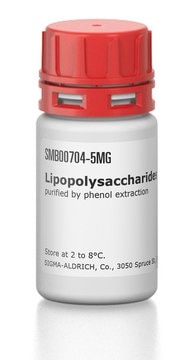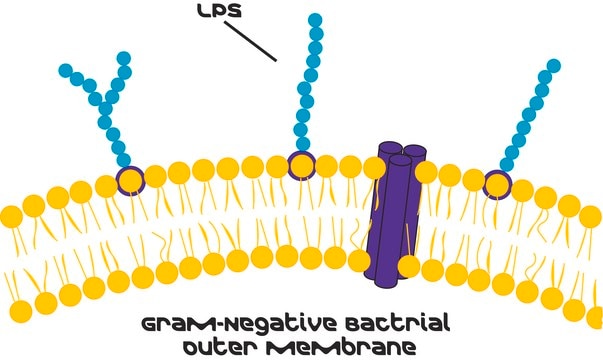SMB00801
Lipopolysaccharides from Proteus vulgaris
purified by phenol extraction
Synonym(s):
LPS
Sign Into View Organizational & Contract Pricing
All Photos(1)
About This Item
UNSPSC Code:
12352211
Recommended Products
biological source
bacterial (Proteus vulgaris)
Quality Level
form
lyophilized powder
purified by
phenol extraction
impurities
≤3% Protein (Lowry)
color
white to yellow cast
solubility
water: 4.90-5.10 mg/mL, faintly hazy to hazy, colorless to faintly yellow
shipped in
ambient
storage temp.
2-8°C
Related Categories
General description
Lipopolysaccharides (LPSs) are characteristic components of the cell wall of Gram-negative bacteria. LPS and its lipid A moiety stimulate cells of the innate immune system by the Toll-like receptor 4 (TLR4), a member of the Toll-like receptor protein family, which recognizes common pathogen-associated molecular-patterns (PAMPs).
Lipopolysaccharides (LPSs) are characteristic components of the cell wall of Gram-negative bacteria. They consist of lipid A moiety linked to an antigenic O-polysaccharide.
Proteus vulgaris is a rod-shaped Gram-negative, facultative anaerobe bacterium. It inhabits the intestinal tract of humans and animals and can be found in soil, water and feces. P. vulgaris is a member of the Enterobacteriaceae family which are opportunistic pathogens in humans, responsible for urinary tract and burn infections.
The chemical structures of LPS from Proteus sp. are different from each other.
Proteus vulgaris is a rod-shaped Gram-negative, facultative anaerobe bacterium. It inhabits the intestinal tract of humans and animals and can be found in soil, water and feces. P. vulgaris is a member of the Enterobacteriaceae family which are opportunistic pathogens in humans, responsible for urinary tract and burn infections.
The chemical structures of LPS from Proteus sp. are different from each other.
Biochem/physiol Actions
LPS and its lipid A moiety stimulate cells of the innate immune system by the Toll-like receptor 4 (TLR4), a member of the Toll-like receptor protein family, which recognizes common pathogen-associated molecular patterns (PAMPs). Different chemical structures of LPS can be associated with the virulence and pathogenesis of the bacteria. It has been reported that the LPS chemical structure from P. vulgaris can influence the crystallization of mineral urine components (such as calcium and magnesium), resulting in stone formation in the kidney. Antibodies produced in rickettsial infections were found to react with LPS from Proteus vulgaris and Proteus mirabilis. This phenomenon allows the purified LPS from these two species to serve as a tool for the diagnosis of rickettsiosis (scrub typhus, caused by the bacterium Orientia sp.) in the Weil-Felix test.
Other Notes
To gain a comprehensive understanding of our extensive range of Lipopolysaccharides for your research, we encourage you to visit our Carbohydrates Category page.
related product
Product No.
Description
Pricing
Storage Class
11 - Combustible Solids
wgk_germany
WGK 3
flash_point_f
Not applicable
flash_point_c
Not applicable
Certificates of Analysis (COA)
Search for Certificates of Analysis (COA) by entering the products Lot/Batch Number. Lot and Batch Numbers can be found on a product’s label following the words ‘Lot’ or ‘Batch’.
Already Own This Product?
Find documentation for the products that you have recently purchased in the Document Library.
LPS/TLR4 signal transduction pathway
Lu, Y.C., Yeh, W.C., Ohashi, P.S.
Cytokine, 42, 145-151 (2008)
S Mizushiri et al.
Microbiology and immunology, 34(2), 121-133 (1990-01-01)
The lipopolysaccharides (LPS) extracted from Proteus strains OX2, OX19, and OXK used as antigens in the Weil-Felix test, were characterized by chemical analysis and SDS-polyacrylamide gel electrophoresis (SDS-PAGE). To separate the O-polysaccharide, core-oligosaccharide, and lipid A moieties, each LPS was
B Bartodziejska et al.
European journal of biochemistry, 256(2), 488-493 (1998-10-06)
The following structure of the O-specific polysaccharide chain (O-antigen) of the Proteus vulgaris 032 lipopolysaccharide (LPS) was established by 1H-NMR and 13C-NMR spectroscopy, including two-dimensional NOESY and H-detected 1H,13C heteronuclear multiple-quantum coherence (HMQC) experiments: -->2)-alpha-L-RhapI-(1-->2)-alpha-L-RhapII-(1-->4)-beta-D-++ +GalpA(I)-(1-->3)-beta-D-GlcpNAc-(1-->4)-alpha-D-GalpA(II)-(1-- >. In addition, an
Agnieszka Torzewska et al.
Journal of medical microbiology, 52(Pt 6), 471-477 (2003-05-16)
Formation of infectious urinary calculi is the most common complication accompanying urinary tract infections by members of the genus Proteus. The major factor involved in stone formation is the urease produced by these bacteria, which causes local supersaturation and crystallization
A Torzewska et al.
FEMS immunology and medical microbiology, 31(3), 227-234 (2001-11-27)
The O-specific polysaccharide (O-antigen) of the lipopolysaccharide (LPS) of Proteus vulgaris O37 was studied by (1)H and (13)C nuclear magnetic resonance spectroscopy before and after O-deacetylation and found to be structurally similar to that of P. vulgaris O46 studied earlier.
Our team of scientists has experience in all areas of research including Life Science, Material Science, Chemical Synthesis, Chromatography, Analytical and many others.
Contact Technical Service

